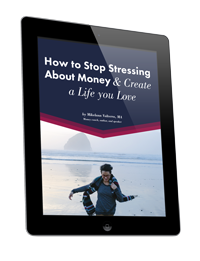I’m as human as the next person. Sometimes I want to spend money I shouldn’t. Take clothes, for example. For Christmas, my father gave me some very generous clothing gift certificates. So I hit the after-Christmas sales pretty hard with my friend Sandra. Between the sales and my gift certificates, it was like everything was free! We shut the mall down a couple of nights… Well, when the gift certificates ran out, I kept going.
All of a sudden, I couldn’t stand my clothes and I felt this full blown need to fix my entire wardrobe. As my mentor Karen McCall has always taught me, one of the most dangerous things people do is confuse their needs with their wants. (Click here for Karen’s recent post on this.) The truth was that while I wanted an entire new wardrobe RIGHT NOW, I really only needed some new clothes to fill in some gaps in my closet.
So when dad’s gift certificates ran out, and my own planned clothing money hit its limit (because I did plan to spend some of my money on clothes—but really—I couldn’t spend ALL of my money on clothes!) I finally turned to a money coaching mind trick. I knew I needed to start watching my spending. But the truth was that I wasn’t in the mood to think deeply right in the middle of my shopping expedition with Sandra. So I did a quick “life-energy” calculation on the lovely shoes I was eying at Nordstrom.
I learned about calculating “Life-Energy” years ago from Vicki Robins. (Vicki Robins co-wrote, with Joe Dominguez, the book Your Money or Your Life.) In their seminal book, they discuss at length the idea that we are all trading our life-energy—the hours in our life—for money. In essence, the question is: How much life-energy does it really take to make a certain amount of money? And is an object/service/experience worth the amount of life-energy you’re going to expend for it? How much life-energy was I going to spend on those shoes?
Here is how to calculate your life-energy number:
Step one: Let’s assume you make a salary of $72,000 a year. That is your gross salary. But really, you don’t get to keep all of that. So what is your net? After taxes and deductions, what amount actually gets deposited in your account? Let’s say your net is $5,000 a month.
Step two: What other costs are associated with making that money? Do you have to maintain an expensive wardrobe or drive an expensive car like that Lexus? Do you have to eat out for lunch a lot? Are you so tired at the end of the day you eat dinner out more than you would prefer? Let’s say all those costs add up to an extra $600/month. So really, your “net” of truly available money is $4400. ($5,000-$600= $4400. Still with me?)
Step three: How many hours did you REALLY have to work for this $4,400? If you’re salaried, add up all your hours. I vote that you throw in your commute time as well. You wouldn’t be spending those 45 minutes commuting if you didn’t need to work for money, correct? Some people even like to include the time they need to get ready in the morning. I leave that to you. Let’s assume that you add up the time you commute and the hours you are at work. It equals 55 hours.
Step four: Take 55 hours and multiple by the four weeks in a month. You get 220 hours a month. (Technically, there are 4.3 weeks in a month, for those of you who are really being exact.) So you’ve worked 220 hours to get that $4,400 you have available to spend. Now divide your truly available money by the amount of life-energy you had to expend to get it. $4,400 divided by 220 hours is $20. $20 is your “life-energy” number.
If this was my life-energy number, I would use it this way: If I’m in Nordstrom eyeing that pair of $100 shoes, I simply ask myself: are those shoes worth five hours of my life-energy? (I decided no, by the way.)
If I’m contemplating a $600 weekend getaway down to the Oregon coast, I may ask myself, is this trip worth 30 hours of my life-energy?
Is the afternoon spa outing to Gene Juarez with my friends worth seven hours of my life-energy?
You get the point.
Sometimes the answer is yes, and sometimes it is no. But it puts a wonderfully different perspective on things. It acts as a great break at times and really makes you stop and think. So consider taking a few minutes and calculating your own life energy. Then take the back of a business card and write: “My life-energy = $…” Keep this card in your wallet and simply pull it out when you’re not sure you should buy something. How many hours of your life (life-energy) are your really expending on a given purchase?
Try it and let me know what you think!

Great concept, Mikelann. Thank you for sharing. It creates options that put the power of choice back into our hands. I like that!!
Hi Mikelann:
I worked with Karen Mc Call for awhile & have been challenged by the money journey. I realize a major part of how I am with money involves finding out how I learn. I know many of us learn differently. I’m a student of Diamond Heart (Ridhwan Center in Berkeley) & once a month I attend a $ class taught by a woman who connects the dots more with money because she makes it more relational & therefore more feminine. Suddenly things make so much more sense to me. She gave us an assignment about our money & our life energy & I didn’t understand how to do it. Thank you because now I have a very clear illustration of how it works.
Blessings & so many thanks,
Kate